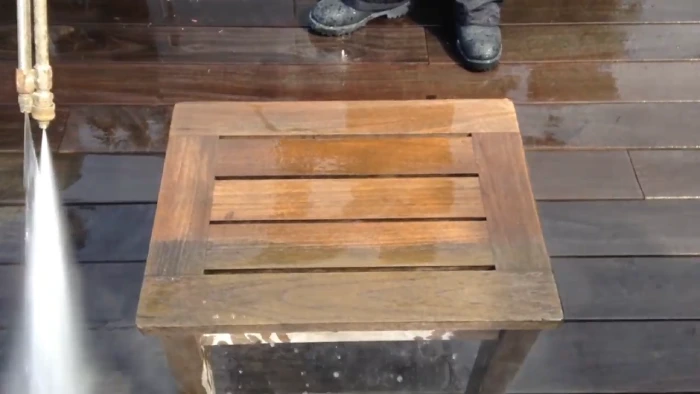Last Updated on October 18, 2023
Teak shower benches are a luxurious addition to any bathroom and certainly make showers more enjoyable. But despite their beauty, they can quickly become tarnished if not properly cared for, and mold is the biggest culprit.
To maintain its pristine condition and aesthetic charm, it’s essential to know how exactly to clean those nasty patches of mold off teak shower benches.
There are a couple of reliable ways to get it clean. And the good news is you probably already have what you need. All it takes is vinegar & dish soap or baking soda, and boom. These are both easy to use, effective at removing mold, and won’t harm the wood surface.
So, don’t let any grime or dirt dull its luster. Get the most out of this investment in no time. Let’s explore how to make it sparkle again.
How to Clean Mold Off Teak Shower Bench: Quick & Easy Methods

Mold on teak shower benches can be a pesky problem that is hard to tackle without the right supplies. Fortunately, combatting it doesn’t require too much time or effort.
Here are the methods & steps:
Method 1: Using Vinegar & Dish Wash Soap
Get these things:
- Water
- A soft-bristle brush
- Dish soap or Detergent
- Vinegar
- Bucket or Bowl
- A spray bottle
- Cleaning sponge or Towel
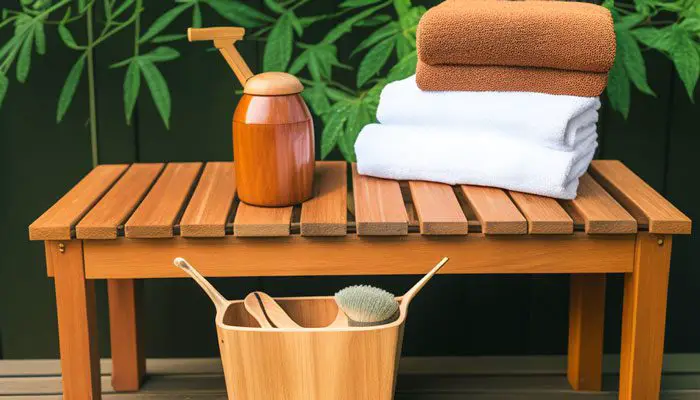
Step 1: Get the Teak Shower Bench Ready
Before you start cleaning the teak shower bench, it is important to get it ready for cleaning. Place a plastic sheet or tarp under the bench to protect your floors from any splashes or spills. Then, use a vacuum cleaner or broom to remove dirt and debris from the surface and between the wood planks of the bench.
Use a microfiber cloth dampened with warm water to wipe away any remaining dirt or dust. Also, ensure that all the cushions on the bench are removed before starting.
Step 2: Create a Cleaning Solution
Mix together a solution of equal parts vinegar and water in a bowl or container of your choice. Once this is done, add two tablespoons of detergent or dish soap to the mixture to increase its effectiveness against mold and mildew.
Stir the ingredients until they blend together evenly into a thick liquid consistency. Depending on their severity, you may need to add more dish soap and vinegar for tougher stains. After creating your solution, pour it into a spray bottle for easy application on the bench surface.
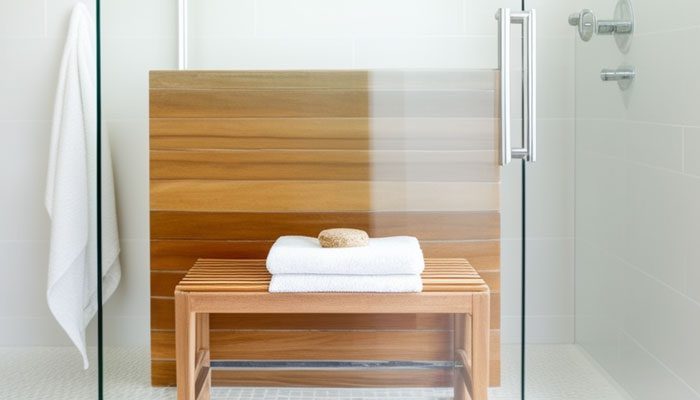
Step 3: Apply the Solution to the Bench
When using the spray bottle, coat the entire surface of your teak shower bench evenly. To do this, spray it from several feet away so that all parts are saturated but not too wet. If you are using a bucket, use your sponge to wet the bench.
Be generous with the water, but don’t use it too much. The liquid will create too many suds and cause streaking when it dries.
Apply the solution to the bottom of the bench and between wood planks, if present, so that they receive an adequate amount of solution. Wait for five minutes before scrubbing them off with a soft bristle brush or nylon-bristled scrub brush.
Note: When cleaning your bench, do not scrub it too hard. Teak wood is easy to damage if you scrub it too much.
Step 4: Rinse and Dry The Bench
Once you have finished scrubbing off all traces of mold from your teak shower bench, rinse off all remaining cleaning agents with lukewarm water. Then dry thoroughly with an absorbent cloth or paper towels to prevent any residue from being left behind.
You may also consider using an air compressor or hairdryer in a low heat setting if necessary to get rid of moisture faster during this step. Leaving moisture behind will create an ideal environment for new mold growth over time.
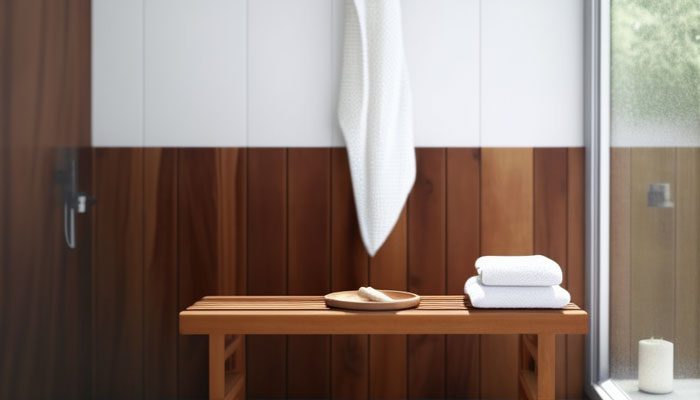
Step 5: Oil the Bench With Teak Oil
It’s important that you protect your newly cleaned teak shower bench with oil to keep it looking fresh and vibrant for longer periods. Apply oil to your shower bench using a cheesecloth or other soft cloth.
This will help reduce staining from any excess oil dripping down onto floor surfaces near your bamboo shower bench due to overuse during application.
Gently rub this oil into every inch of your teak shower bench in slow but consistent circular motions for the best results. Then leave it for at least 7-8 hours before placing items back onto it again once dry to the touch.
Method 2: Use Baking Soda
Things you’ll need:
- Water
- Baking soda
- Mixing Bowl
- soft-bristle brush
- Cleaning sponge
Step 1: Make a Cleaning Paste
Start by making a paste using baking soda and water. Combine one cup of baking soda with two tablespoons of water in a bowl, stirring to form a thick paste.
You can also add other natural ingredients, such as essential oils or vinegar, to the mixture if desired. As these can help to further disinfect and remove odor-causing mold and mildew.
Make sure your paste is thick enough to not drip or run off the surface when you apply it. If necessary, add more water or baking soda to adjust the consistency.
Step 2: Spread the Paste All Over
Using a soft cloth or brush, spread the paste evenly over the entire surface of the bench, including any crevices or hard-to-reach areas. Leave the paste on for 10-12 minutes before rinsing it off.
Make use of a brush to scrub areas with tougher stains, and let it sit for a few more minutes if needed. This will break down any dirt and grime and make removing it easier during the next step.
Step 3: Clean and Dry the Bench
Once the paste is allowed to sit for 10 minutes, use a damp cloth or sponge to scrub off any remaining dirt or residue from the bench’s surface. Rinse with clean water and allow it to dry completely before using it again.
To further protect your shower bench from future mold growth, use teak wood furniture polish after cleaning and drying to give it an extra layer of protection against moisture.
Why Does a Teak Shower Bench Get Moldy?
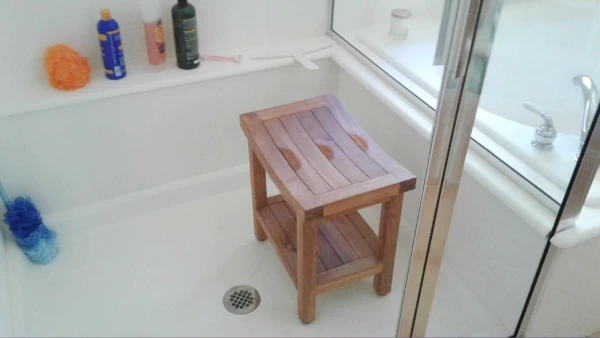
Bathrooms are full of moisture, and mold loves it. That’s why it’s important to know the reasons why a teak shower bench may become moldy.
Here are five possible causes:
1. Poor Ventilation: Without proper ventilation, moisture lingers in the air and collects on surfaces such as a shower teak bench. This provides the perfect environment for mold spores to multiply and spread.
2. Temperature Fluctuations: It’s no secret that changes in temperature cause moisture issues in bathrooms. When temperatures fluctuate from warm to cool, condensation can collect on surfaces such as teak shower benches and provide the ideal environment for mold growth.
3. Too Much Moisture: If your bathroom is too humid or you use too much water when bathing or showering. This extra moisture can create the perfect breeding ground for molds and fungi on your teak shower bench surface.
4. Lack of Protection: Teak benches are naturally resistant to weathering but still need some protection from water damage over time. If they are not treated with oil regularly (about every six months), they may become discolored or moldy from too much exposure to moisture.
5. Standing Water: If you find yourself with standing water on your shower bench, it’s essential to take care of it as soon as possible. The trapped moisture can be a breeding ground for molds and bacteria if left untreated.
How to Keep a Teak Shower Bench From Mildewing?

Are you concerned that mildew may build up on your teak shower bench? If so, don’t worry. You can keep your teak shower bench from mildewing with proper care and regular maintenance.
The following tips can help prevent mildewing:
Clean the Teak Shower Bench Regularly: To prevent mildew growth, it’s essential to clean your shower bench regularly. Make sure to use a soft cloth or brush, warm water with a gentle soap or detergent, and thoroughly rinse the bench afterward.
Dry Thoroughly After Each Use: As you know from above, it’s also important to dry your shower bench after each use. You should towel dry the bench’s surface after each use. Pay extra attention to any areas with hard-to-reach crevices.
Install an Exhaust Fan In Your Bathroom: A bathroom exhaust fan is essential to preventing mold growth on your shower teak furniture. The exhaust fan helps remove moisture from the air and prevents moisture accumulation on surfaces such as the shower bench.
Open Your Bathroom Window When You Shower: Opening the bathroom window when you take a shower is another great way to prevent mildew buildup on your teak shower furniture. By doing so, fresh air will be circulated into the room, reducing humidity levels and moving moisture away from surfaces quickly.
Don’t Leave Wet Towels on Your Teak Shower Bench: It’s tempting to leave wet towels draped over the top of your teak shower bench after taking a bath or shower.
But this can be a source of excess moisture that can lead to mold growth on the wood surface of the bench over time. Instead, hang damp towels up over door knobs or towel racks nearby.
Use Covers When Not In Use: If you aren’t using your teak shower seat for extended periods of time, consider investing in covers. Most of these are made of breathable fabrics, like cotton, which provides superior protection against dust & debris buildup, which can lead to mildew formation.
Treat Spots & Stains Immediately: When you spot any signs of spotting stains or discoloration, treat them immediately by either wiping them off with warm soapy water (for non-porous surfaces). Or through sanding down & treating them with appropriate wood oils/teak sealer etc.
How Often Should You Clean a Teak Shower Bench?
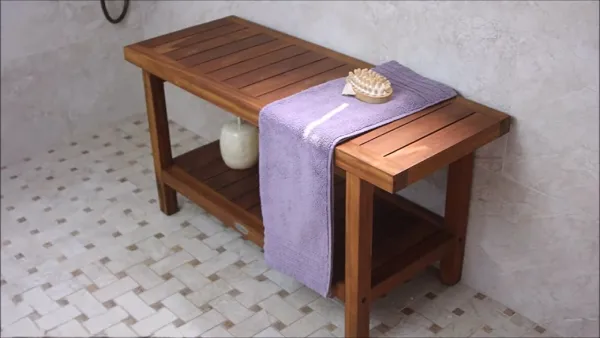
You should clean your teak shower bench every 2-3 months or more if you use it often. This will help keep it looking nice and ensure it doesn’t have dirt, germs, mold, or any other bad stuff.
Regular cleaning also helps maintain its chic appearance, as well as preventing any potential damage from moisture or other environmental factors. Plus, it’s easy to keep your shower bench looking as good as new for a long time.
What Makes a Teak Shower Bench Smell?
Several different factors could cause a smelly teak shower bench. The most common culprit is dirt and bacteria that have built up over time due to a lack of regular cleaning.
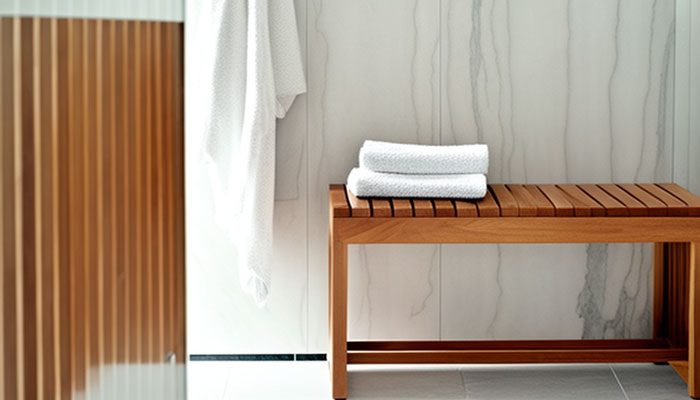
Unwanted odors can also come from things such as pet hair, smoke, food particles, body oils, and sweat that get trapped inside the wood pores. Besides that, if you don’t seal teak wood when you buy it, it can develop solid and musty smells over time because moisture seeps into the wood grain.
Is Oil Necessary to Prevent Mold Growth On Teak Shower Benches?
Applying oil on your teak furnishings helps protect them from moisture damage by creating a layer that prevents moisture from entering the wood fibers of your teak furniture. This means there is less chance for mold to grow because there is no stagnant water and fewer bacteria.
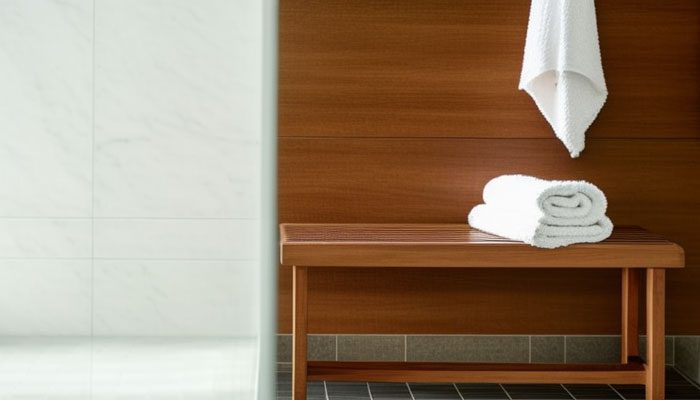
It also discourages mildew from growing in often wet places, like bathrooms and showers. This layer also provides UV protection which helps maintain its natural color while preventing sun fading and other discolorations from occurring over time.
Keep Your Teak Shower Bench Glowing with Regular Cleaning
Protecting your teak wood shower bench doesn’t just make it look good, and it also helps ward off mold so you can enjoy its beauty and utility. With regular cleaning and maintenance, you’ll be able to keep this classic wood looking as magnificent as the day it was installed.
If you discover any mildew or dirt on your shower bench, follow these easy steps to clean it up before applying a protective coating or sealant. Even after spending a lot of time in wet environments, your teak shower bench will remain stunningly beautiful and free of mold.

